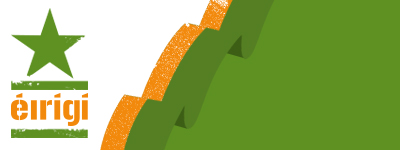Successful Public Meeting Builds Momentum For 'Julia Morrissey Bridge'
Last night saw Éirígí Gaillimh hold a successful public meeting as part of the ‘Julia Morrissey Bridge' campaign. The meeting which took place in Áras na nGael on Dominick Street in Galway City, was attended by up to thirty people.
The campaign is calling for Galway's new pedestrian and cycle bridge (adjacent to the existing Salmon Weir Bridge) to be named in honour of 1916 veteran, Julia Morrissey. The campaign includes an online petition, which has been signed almost 400 times. You can show your support by signing the petition here.
Julia Morrissey and an artists impression of the new Corrib pedestrian and cycle bridge that should bear her name
Last night’s meeting was chaired by Éirígí Galway representative, Ian Ó Dálaigh and addressed by guest speaker, Jamie Canavan. Jamie is a PhD student in NUIG, whose thesis (which is sponsored by the Irish Research Council) examines foster care in 20th century Ireland.
Her talk included some background on both Julia Morrissey and the Cumann na mBan movement in Galway during the revolutionary period. Morrissey was clearly a natural leader, who was committed to the republican vision.
Canavan also spoke about the contrast between the role of women during the revolutionary period, and the treatment of women following the counter-revolution of 1922.
Jamie Canavan speaking about Julia Morrissey, Cumann na mBan and the role of women in the revolutionary period and beyond
Speaking after the meeting, Ian Ó Dálaigh said: "This is the first public meeting we have organised in Galway since before Covid-19, so it was very encouraging to see a large crowd gather to discuss the Julia Morrissey Bridge campaign. Many thanks to our guest speaker, Jamie Canavan, for her brilliant contribution.
For Éirígí Gaillimh, it's really important that we try to honour a forgotten hero of the 1916 Rising - a Galway native and Cumann na mBan commander who, like so many other women, have been airbrushed out of history.
Ian Ó Dálaigh giving the background to the campaign and its wider political context
We also want this campaign to spark a conversation about both the role of women during the revolutionary period, and about the nature of the counter-revolution that took place in Ireland 100 years ago.
That counter-revolution was led by reactionary forces, including the Irish capitalist class, big farmers, and the Catholic Church. Their success marked a huge defeat for progressive forces, including those who advocated for women's liberation.
In the years and decades that followed this counter-revolution, the Twenty-Six County state introduced a raft of measures that were designed to largely exclude women from public life and instead confine them to the roles of mother and home-maker. And 100 years later we are still fighting to roll back some of those misogynistic measures.
Some of those who attended last night’s meeting to honour a 1916 hero who was airbrushed from history
Éirígí is committed to fighting for a New Republic that will end false divisions and gender-based discrimination. Naming the new bridge in Julia Morrissey's honour would be a fitting tribute to Julia the woman, and to the radical republican ideal that she risked life and liberty for. The campaign is also an ideal way to contribute to the conversation on the issues women in Ireland are facing today.
I would encourage the people of Galway to sign our petition, share it with family and friends, and to get involved with the campaign. Together we can belatedly pay tribute to one of Galway's forgotten republican heroes".





